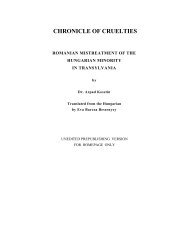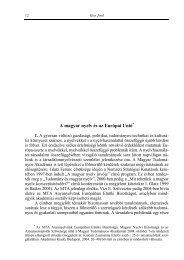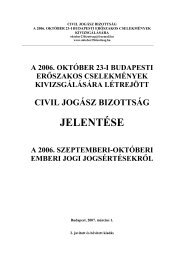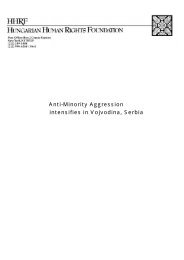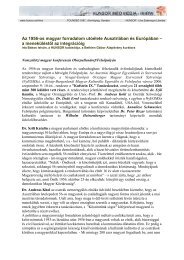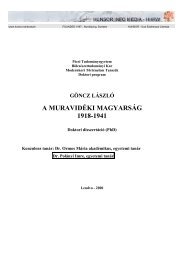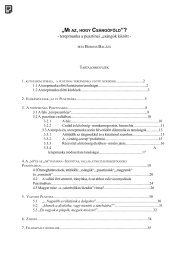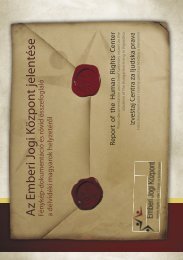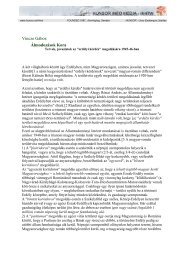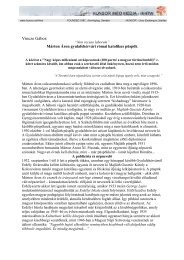121PACSERAt Pacser sixteen Serbians fell in the shootings in 1941. Two hundred Hungarians had tosuffer death for it. It was the butcher, Ivo Jovkovics, who organized the administration of"justice" and the death-ceremony on the road leading to Bajmok, where three big mass graveswere dug with the help of the Third Battalion of the Eighth Brigade of Vojvodina. They picked adistrict inhabited by Hungarians and those who were found there were all driven to their graves.The Rev. Jozsef Kovacs was seized separately. In the course of an inspection, an officerof the brigade recognized Kovacs as an old schoolmate. It was not easy for him to save thepriest, as his accuser, since a church going Catholic Serb insisted that the priest was a greatenemy of the Serbs. He had often been heard glorifying the Virgin Mary, protector of theHungarians. The priest, no longer under threat of death, tried to save the villagers alreadyrounded up, but the partisans of the Third Battalion preferred to follow the butcher, IvoJovkovics. Even the old schoolmate supported his efforts, but the two hundred Hungarians had todie anyway. On their grave, the dissembling, careful, Serbian generations planted wisteria, tocover the crimes of their fathers.BAJMOKThe local Hungarian Counter Intelligence Group took thirty-five Serbians toconcentration camps, although the burgomaster pleaded their innocence with his peasantnaivete.In the middle of October 1944, the Russian troops occupied Bajmok, and the partisansappeared on their heels with people who had been released from captivity by the CounterIntelligence Agency. They brought with them an ardent desire for action, which was a desirefor reprisal. On the first night of their arrival they rounded up seventy-eight Hungarians and twoGermans. They tortured them for days at the Village Hall; pretending they were selecting some.One or two friends were saved by some Serbians through a side door of the movie house, wherethe people to be executed were kept. That is where the Pharmacist, Erno Jeszenszki, the owner ofthe pharmacy called "Guardian Angel" was held. He was known for his willingness to helpanybody who came for help. Apart from being a Hungarian, he122was found guilty of being knighted by Regent Miklos Horthy in 1941 for his heroism in WorldWar I. <strong>This</strong> was considered by Titoist and Stalinist standards, equal to being a Fascist.After long tortures, the partisans took their captives to the clay pits near the railwaybridge, where they shot their victims by the hundreds. The bloody work was easier since they didnot have to dig, just dump soil on the bodies. The owner of the previously mentioned pharmacywas thrown on the heap too.The males of the village fled to the edge of the village where they spent the night in thecornfield so they would not be found. Those who joined the workers in the field during the day
had done so in wain, since the the partisans herded the villagers into the moviehouse, theanteroom of hell, together with their hired workers. The number of victims slowly rose to onehundred and fifty. Later on new pits had to be dug at the railway bridge, the old ones now beingfull. The newly arrived, foreseeing their destiny in the dead bodies laying there, first coveredtheir fellows with soil, then made room for themselves before they surrendered, half naked, tothe machine guns. The inhabitants of the nearby farms had to listen in horror to the constantrattling of guns and the cries "Help, Hungarians!"The murderers left no burial mound. If there was a mound they stamped it into theground, singing and dancing triumphantly.The following spring, when the farmers horses went to plough, they sensed that the fieldno longer supported life. The horses reared, snorting, when they approached the field. That field,consecrated by Hungarian bodies, remained unplowed due to the homage paid to it by thesehorses. The people who were left behind kept coming back to pick up a rag, a cap, or a shoe,which were useless to the executioners.The fate of the Judge Karoly Czimbell deserves special notice. We have alreadymentioned him - anonymously - as one who did his best to save his Serbian fellows. Theretreating gendarmes warned him to get away because he would be the number one enemy of thepartisans, since he was in a responsible position. He did not ignore the warning, although hebelieved that he was innocent. He went along in painful march with the gendarmes as far asBaja, but there he got on a cart going to Bajmok and returned to his family after a few daysabsence. He did not even have time to take a bath before the partisans came to get him. Theykept in mind his suspicious though short absence. After a short beating they skinned CzimbellKaroly alive before putting him on a truck and throwing him into the mass grave without hisskin; he was still breathing.123SZABADKAThe town, which inaugurated its new Major, Andor Rokk, on January 19, 1942, wasspared by the raid of the partisan hunters. Serbian data from 1946 says that during the days whenthe Hungarians came in, one hundred and forty-seven Serbians fell victim to the change ofregime in April 1941. They never mentioned the number of Hungarian deaths. The Hungariansof Szabadka had to pay a high price for this in the fall of 1944.The town was occupied by the Russians and the partisans on October 10. After a fewdays orientation, they started to round up the Hungarians. At dawn they drove their jeeps to getthose who they had singled out. There was always a Russian soldier with them, accompanied bypartisans wearing machine guns. To keep things moving along smoothly, they kept saying thatthe person summoned as a witness at this early hour was to be taken in only to give a statement.These witnesses, who were never interrogated, were either taken to the barracks on Palicsi Streetor to the yellow house in Agnes Lane, to the much feared Counter Intelligence Center of theHome Affairs Authorities. After being severely tortured, the only place for them to go was thecemetery.Here, without any trial, verdict, or even an explanation of any kind they were shot and dumpedinto the pit. Beyond the seedy buildings of the old hospital (now a factory) on a clearly outlined
- Page 3 and 4:
Library of Congress Catalogue Card
- Page 5 and 6:
Mutilation of the hands or feet wit
- Page 7 and 8:
they wanted to belong. On the annex
- Page 9 and 10:
individuals, then shooting them by
- Page 11 and 12:
the Russians and under their protec
- Page 13 and 14:
22PEOPLE OF BEZDAN1.On a May aftern
- Page 16 and 17:
26that those people all fell victim
- Page 18 and 19:
ack a 13 year-old boy to the soccer
- Page 20 and 21:
Russian officers cursed and told th
- Page 22 and 23:
Jani was set free for he had been a
- Page 24 and 25:
There were some people who, in spit
- Page 26 and 27:
March 12, 1945. The relatives of th
- Page 28 and 29:
Ferenc Csapo, 33 Mihaly Miovacs, 18
- Page 30 and 31:
Having heard about the advance of t
- Page 32 and 33:
"On November 3, I got up at five in
- Page 34 and 35:
The vicar would come every night. H
- Page 36 and 37:
hand. Raising it to his mouth, he d
- Page 38 and 39:
"24th October, 1944. Yesterday was
- Page 40 and 41: "I have only one chance to be sacri
- Page 42 and 43: The data, which shows that on the s
- Page 44 and 45: all the captured Serbs, as neither
- Page 46 and 47: Before and during World War II, the
- Page 48 and 49: would order fire in an instant. Wit
- Page 50 and 51: Our house looked out over the main
- Page 52 and 53: He had just arrived home after thre
- Page 54 and 55: 28. Jozsef Pasztor, 34 56. Albert G
- Page 56 and 57: The OZNA officer, who exhumed a mas
- Page 58 and 59: 7917 year old Karoly and 8 year old
- Page 60 and 61: 82FROM SZENTFULOP TO THE GAKOVA CAM
- Page 62 and 63: My mother died on January 4, 1946.
- Page 64 and 65: Jozsi, the leader of our committee
- Page 66 and 67: his own grave, then machine gunned
- Page 68 and 69: driving a wheelbarrow on the sidewa
- Page 70 and 71: "Now that's exactly what we needed
- Page 72 and 73: 15 Istvan Polyakovics, Zenta, 18861
- Page 74 and 75: idge was built (from several rows o
- Page 76 and 77: There is a common opinion among the
- Page 78 and 79: The Catholics of the village were o
- Page 80 and 81: and their supporters. On one occasi
- Page 82 and 83: "My younger brother, Bandi, was tak
- Page 84 and 85: two young instructors staying in he
- Page 86 and 87: In Tunderes (Vilova) there was no o
- Page 88 and 89: weeks spent starving, laying on str
- Page 92 and 93: piece of land, there are three rows
- Page 94 and 95: "I understood that through the OZNA
- Page 96 and 97: took the priest under their protect
- Page 98 and 99: "We set off from Hadikliget on Octo
- Page 100 and 101: everyone to the front! The Party us
- Page 102 and 103: 137REPORT OF LOSSESIn addition to o
- Page 104 and 105: 141Source: Zlocini okupatora u Vojv
- Page 106 and 107: well as in words, that there had be
- Page 108 and 109: The American military forces delive
- Page 110 and 111: culpability or participation are th
- Page 112 and 113: The accused did not make use of his
- Page 114 and 115: the spirit of revenge among the Hun
- Page 116 and 117: considered all the claims of Hungar
- Page 118 and 119: The People's Court of Budapest just
- Page 120 and 121: From then on all hell breaks loose.
- Page 122 and 123: Recommended readingeRudolf Kiszlion



